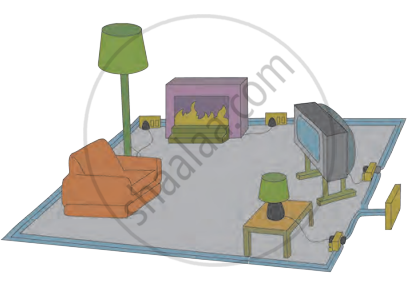Advertisements
Advertisements
प्रश्न
Study the three electric circuits below. Each of them has a glass rod (G), a steel rod (S), and a wooden rod (W).
In which of the electric circuits would the bulb not light up.

पर्याय
A only
C only
A and B only
A , B and C
उत्तर
A and B only
APPEARS IN
संबंधित प्रश्न
The accompanying figure shows some electrical appliances connected in a circuit in a house. Answer the following questions.
- By which method are the appliances connected?
- What must be the potential difference across individual appliances?
- Will the current passing through each appliance be the same? Justify your answer.
- Why are the domestic appliances connected in this way?
- If the T.V. stops working, will the other appliances also stop working? Explain your answer.

If you touch an electric wire carrying current you get a shock, but if on the same wire the birds sit they do not get any shock/current. Explain why?
In the circuit diagram below, 10 units of electric charge move past point x every second What is the current in the circuit ______.

The rate of flow of electric charges in a circuit is called ______.
In a circuit, if the key is in open (off) condition, then electricity will not flow.
Observe the circuit given:
1. Would any of the bulbs glow when the switch is in the ‘OFF’ position?

2. What will be the order in which the bulbs A, B, and C will glow when the switch is moved to the ‘ON’ position?
The ______ is a species of fish that can give electric shocks of up to six hundred fifty watts of electricity.
Paheli connected two bulbs to a cell as shown in Fig. 12.8.

She found that filament of bulb B is broken. Will the bulb A glow in this circuit? Give reason.
How is Joule's law effect useful in electric circuits where fuse is used as a safety device?
